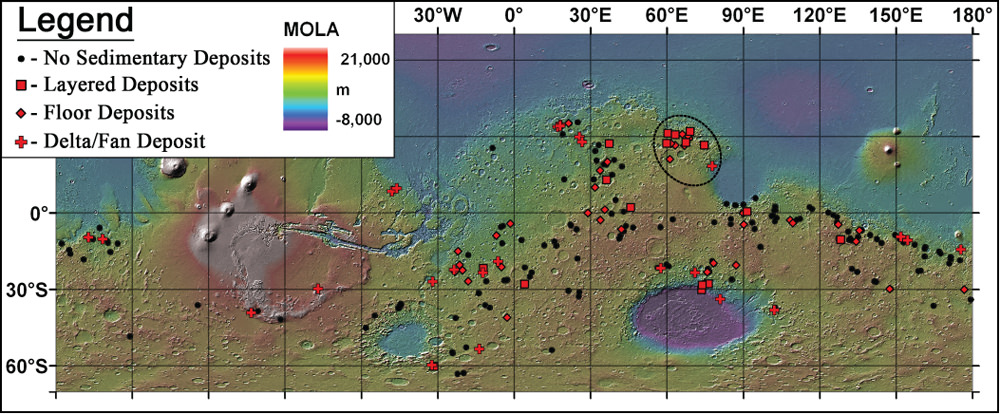[/caption]
Mars was once a much wetter world than it is now, with hot springs, rivers, lakes and perhaps even oceans. Just how wet exactly, and for how long, is still a subject of considerable debate. One vital clue comes from clay mineral deposits and sediments left over after the water disappeared, but still visible now. They provide a valuable insight into what Mars used to be like, and why it is the cold, dry place we see today.
A team of scientists from Brown University has just completed a new study of ancient lake beds on Mars, specifically looking at the clay deposits within them, to try to determine how many of these lakes still contain such deposits and their composition. So what do they tell us about conditions on early Mars? How does this affect the search for evidence of life?
 As it turns out, about a third of the lake beds examined still show evidence for clay deposits. A total of 79 lake beds out of 226 studied to be exact, indicating that they are less common on Mars than on Earth. The reason for this may be that the chemistry of the water was not ideal for preserving clays or that the lakes were relatively short-lived.
As it turns out, about a third of the lake beds examined still show evidence for clay deposits. A total of 79 lake beds out of 226 studied to be exact, indicating that they are less common on Mars than on Earth. The reason for this may be that the chemistry of the water was not ideal for preserving clays or that the lakes were relatively short-lived.
The paper was just published in Icarus on March 2, 2012.
From the abstract:
“These results indicate that hydrated and evaporite minerals are not as commonly associated with lacustrine deposits on Mars as they are on Earth. This suggests in situ alteration and mineral precipitation, a common source of such minerals in terrestrial lakes, was not a major process occurring in these paleolacustrine systems, and that the observed minerals are likely to be present as transported material within the lacustrine deposits. The lack of widespread in situ alteration also suggests that either the water chemistry in these paleolake systems was not conducive to aqueous alteration and mineral precipitation, or that the open-basin lake systems were relatively short-lived.”
Images for the study came from the Mars Reconnaissance Orbiter, Mars Odyssey and Mars Express spacecraft.
Clay deposits have become a primary focus of study by orbiters and rovers, as they could preserve fossil traces of early life, just as they do on Earth. Even if they are less common on Mars, the fact that they do exist there is exciting, and there is now much interest in exploring them further. Apart from underground, they are the best places to look for such evidence of life. It is also possible that additional deposits have been buried underground, waiting to be discovered.
The Opportunity rover is currently very close to a treasure trove of clays in Endeavour crater, and it is expected to head straight for them after its winter “hibernation” is over in the next few months. The Curiosity rover, en route to Mars right now, will land in Gale crater next July, where there are also clay deposits near the base of a mountainous peak within the crater. Gale crater is thought to be another site of a former Martian lake.
The abstract is available here (with full paper available for purchase).


“…The Opportunity rover is currently very close to a treasure trove of clays in Endeavour crater,…”
Clays are not IN the crater but are in the outcrop surrounding it.
From the paper titled “The Stratigraphy, Composition and Thermophysical Properties of Endeavour Crater, Meridiani Planum, Mars, from Orbital Remote Sensing”
“The Endeavour crater raised rim
units appear different, visibly and spectrally, from the
majority of surrounding terrain and have been
interpreted as ancient strata [15]. CRISM spectra
reveal phyllosilicate (Fe/Mg-smectite clay)”
and later on it says:
“Spectral signatures of basalt and
hematite are more enhanced on the crater floor than the
plains.”
Paper can be downloaded from Harvard’s SAO/NASA Astrophysics Data System website here: http://adsabs.harvard.edu/abs/2010LPI….41.2175C
Tracking Gate: GPS Tracking, Assets , vehicles, Online Tracking , Fleeting Technology, GIS Services http://bit.ly/FOeSYx
Given that Mars has had innumerable planet wide dust storms over the milena since the lake beds were formed, it is very possible that more deposits are present, but buried.